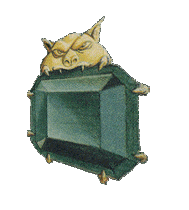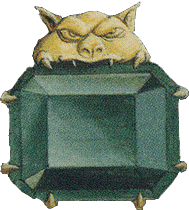
Talking Shop: Workshops Aggro and The Battle for the Sound
By stsully
May 20, 2019
On May 4th, 2019, in Tacoma, WA, The Horde, Geek Fortress, and Brainstorm Games put on The Battle for the Sound, an amazing event that included an Old School tournament hosting a field of 77 mages. This fantastic tourney raised several hundred dollars for FareStart and featured six of the original Alpha Magic artists doing signatures, alters, and custom artwork. The general consensus from all who played was that the event was a smashing success. Oh, and there were also like some people playing with new cards in Legacy, Modern, and CanLander events too.
One of the stories of the tournament was that five (!) out of the final Top 8 decks were Workshops Aggro decks, featuring the signature broken card Mishra's Workshop:

I piloted one of those decks to a top four finish, beating another Workshops deck in the quarterfinals and losing to yet another Workshops deck (and the eventual tournament winner) in the semifinals. With so many decks of one archetype showing up in the Top 8 of a major event, it seemed worth asking: what is this deck, and what happened at this tournament for it to explode so dramatically?
The Workshops Aggro Archetype
Workshops decks have been a strong archetype ever since the card was printed. To this day it's still a top-tier force in Vintage, continually on the watch list for restriction and powering some of the (arguably) least fun decks in the format. It's also restricted for power level in Swedish Old School rules, though it's unrestricted in Atlantic and Eternal Central.
In a deck full of artifacts built to maximize its potential, meaning big CMC artifacts with minimal or no mana cost to use, it is essentially an every-turn Black Lotus. Very powerful.
Its recent popularity spike in Old School began, to my knowledge, with Martin Berlin's Workshops Aggro deck from the 2018 Fishliver Cup. Martin described it in an episode of All Tings Considered and does a great job explaining how it works. Here is Martin's deck:
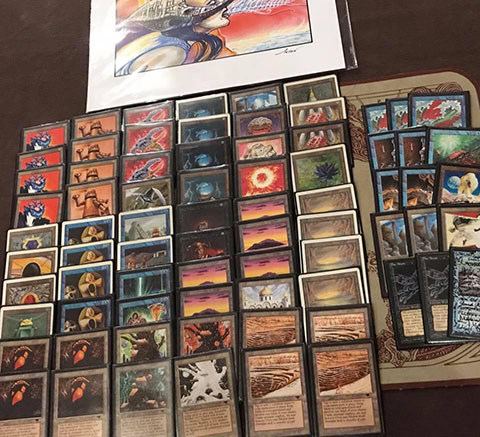
Several of the So-Cal Deep Spawners had also realized its potential and have been playing it for a while; three of the Top 8 were Deep Spawners playing Workshops. I picked it up shortly before the tournament when Pez Unholy, a great friend to both me and the Deep Spawners, turned me on to it, since I already owned the Workshops. Tacoma was actually my first time playing it in an event -- I had switched to it from URB Troll Disco the week before the tourney.
Here are a few of the Workshops Aggro decks from the Top 8:
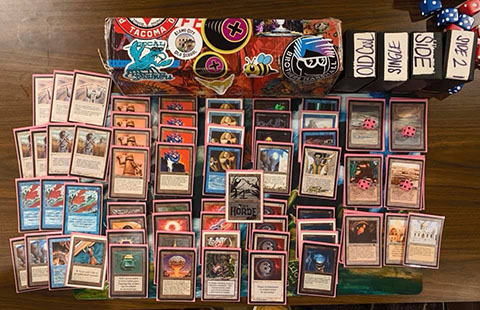
Nick Aiello's winning list
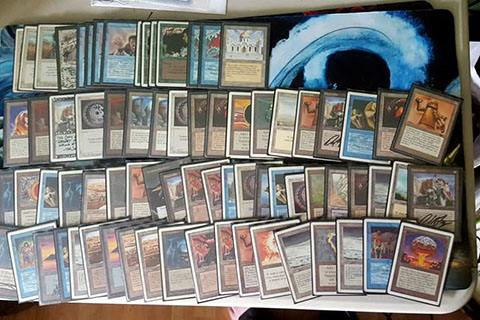
Michael Butzen's Top 8 list
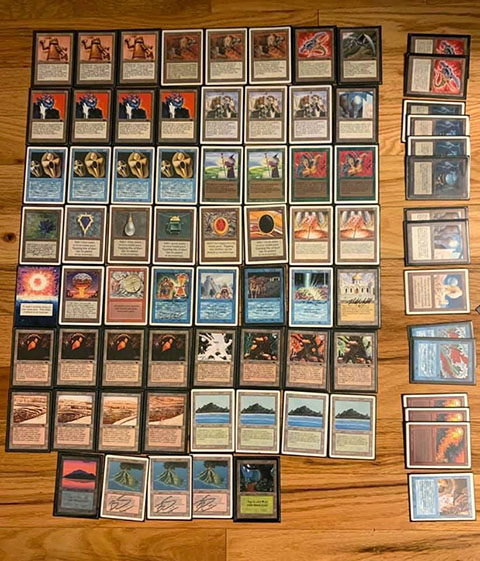
My Top 8 list
Looking at the commonalities in those lists, it's clear that Workshops Aggro wants to be two things: fast and big. With Black Lotus, 4 Workshops, all 5 moxen, Sol Ring, and perhaps a Mana Vault or two, it's pretty common to play a CMC 4+ artifact on turn one, then repeat the process the next few turns.
Sometimes those are threats in need of an immediate answer before they put the game out of reach, like Su-Chi, Juggernaut, or Triskelion. Other times it's an Icy Manipulator, the control jack-of-all-trades that can stymie an opponent's early development even while the Workshops player keeps casting more and more big artifacts. If the Workshops player has any Strip Mines to follow an Icy, or just another Icy, an opponent who kept an entirely reasonable hand can be end up in topdeck mode looking for mana starting turn two or three. Multipurpose all-star Copy Artifact rounds out the core of the deck, providing ramp (by copying a mox/Sol Ring/Fellwar), a threat, or another Icy depending on what you need, all for the low-low price of two mana.
The way it plays out, calling this deck "aggro" mischaracterizes it a bit. Most aggro decks, especially in Old School, play a tight, low mana curve with lots of efficient threats. Workshops Aggro gets a little bit greedier thanks to its namesake card and plays less efficient but bigger threats on a similar timeline as more typical aggro decks. Really, it's as fast as an aggro deck but as big as a midrange deck, and also often tosses in a mana denial/point control subtheme to make sure it can get there before the opponent is able to react. It's a rather unique angle of attack that makes it hard to play against, and because of the deck's dollar cost, it's probably not a deck most players have experience battling or preparing for.
That said, it's not invincible. It devotes a lot of cards to ramp, and beyond Triskelion and Su-Chi, its threats are pretty meh when not powered out 2+ turns early by a Workshop. The deck also has little interaction outside Icy Manipulator (strong, but not a hard solution and importantly not able to be used with Workshops mana), Triskelion (situational), and Strip Mine (strong, but not very helpful when your threats have been answered and you're in topdeck mode). When the deck is hot, you can win a game on turn 4-5 in minutes. But if your opponent answers your first few threats with relatively common solutions like Disenchant, Swords to Plowshares, or Shatter, you can end up empty handed with nothing but a board full of ramp pretty easily. However, either way, it's often clear which way the game is going pretty quickly: Workshops Aggro either sticks a broken start, or it doesn't.
Lastly, it's important to mulligan pretty aggressively with this deck because it needs a quick start off a Workshop or artifact mana, or else it can't cast anything meaningful for the first few turns. You want to explode on turn one with something big, not play land-go until you cast Triskelion slightly ahead of the curve on turn four. Mulliganing to six and even five when you don't have something powerful to do on the first couple turns is important. In fact, a bad non-mulligan decision may have cost me the match in the semis, when I kept a hand of three Factory's and four big artifacts, because my mana just wasn't fast enough.
Why Did Workshops Aggro Do So Well?
Workshops Aggro is clearly a deck with a strong gameplan, but to my knowledge it hasn't shown up in such force at a major event before. Why did it do so well at The Battle of the Sound?
Part of it may simply have been that there were so many Workshops decks at the event: beyond the five in the Top 8, several other Workshops decks did well but didn't make the cut too. Since it's an expensive deck, it seems unlikely that tournaments with this many copies of Workshops being played happen that often. Perhaps a quirk of this event was a much higher proportion of Workshops decks than normal were played. But there may also have been other factors involved in its success.
Workshops Aggro's combination of speed and size may have made it a favorite for the event's metagame. I know for me personally, one of the most attractive aspects of the deck for this tourney specifically was that, one way or another, its matches should end quickly. That was important to me because I wanted to get a lot of cards signed and spend some time meeting the artists.
Playing a fast deck indeed seemed to be a popular choice at the tournament. I know at least a few people who specifically chose a fast deck because they wanted to finish matches quickly and see the artists too, same as me. Some of the artists, like Jesper Myrfors and Brian Snoddy, hadn't been to an event in years, so they were a big part of the overall draw for the tourney. Reduced representation of control and combo would favor a deck like Workshops Aggro, which plays bigger threats sooner than other aggro or midrange decks can manage.
As an anecdotal data point, I only played other aggro decks or midrange decks in the Swiss, and all my Swiss matches were quick (including the one I lost). Another anecdotal data point, after talking to many people at the event, no one who I talked to played against or even saw a copy of The Deck, known to be a grindingly slow way to take a match to Orb flips. These would be consistent with a metagame full of decks designed to turn dudes sideways and burn faces.
With its combination of speed, size, and light but flexible control, Workshops Aggro seems pretty strongly favored in a field like this. It's also unlikely sideboards would be well equipped to deal with Workshops decks. Useful cards like Energy Flux or Shatterstorm might be expected to be present for use against Atogs, but past that the truly useful cards such as Artifact Blast are likely to be pretty thin (note: Blood Moon is less effective than you might think against Workshops, because they can still cast all their artifacts under it). Besides Workshops Aggro being an unfamiliar matchup for many, it might also not be a deck they had the hate cards to combat effectively.
The War Mammoth in the Room
The obvious question after a result like this is whether Mishra's Workshop should be restricted. The Swedes have done it long ago and are pretty comfortable with their decision, I think. What about in EC and Atlantic?
Some might wonder if the presence of 4x Strip Mine in EC makes unrestricted Workshop less menacing there; however, I would submit 4x Strip Mine helps Workshops more than it hurts. The deck runs 9 busted colorless lands (Library, Workshop, and Factory), which means your opponent can't strip them all. Meanwhile, it packs 4 Strip Mines of its own, which combine with Icy Manipulator to form the core control package used in the archetype. In fact, while it's yet to be seen whether this is the case, I suspect Workshops would be less dominant in Atlantic because the Workshops decks can only run a single Strip Mine too.
The price of Mishra's Workshop is also a noteworthy problem. If Workshops really is a dominant deck, it's not very accessible and will always carry the "pay for wins" stigma. No one wants available funds to be the driving factor in how well you are able to do in this format. Further, because it is able to use Icy and Strip Mine to keep the opponent from playing their cards, it's easy to see how some might view it as a not-fun prison archetype that makes the format less enjoyable as a whole. People want to be able to play their cards
All that said, however, I think we need to see what happens at more events first. I do think Mishra's Workshop belongs on the watch list, for being possibly the most powerful unrestricted card in the format and putting up such a showing at The Battle for the Sound. Monitoring its performance will help show whether the specific metagame at that event may have been very favorable to Workshops Aggro. Also, even though it is clearly powerful, the deck was pretty fringe/unknown before this tournament, and many players were surprised by it. I would wager that's not the case anymore, and I think people will be better prepared to combat Workshops in the future.
There are certainly cards that could be effective answers: Energy Flux, Artifact Blast, Hurkyl's Recall, Relic Barrier, Maze of Ith, Blood Moon, Shatterstorm, even spicier stuff like CoP: Artifacts, Haunting Wind, Powerleech, Throat Wolf, or Golgothian Sylex could be effective. Heck, one of the Deep Spawners who was playing Workshops even had two Golgothian Sylex in the board as tech against the other Deep Spawners playing Workshops. So before dropping the banhammer on Mishra's Workshop, I think it's appropriate to see how the metagame responds it. That also appears to be the approach EC and Atlantic are taking, for what it's worth.
Sidebar: Obligatory Deck Tech Section
All right, the last thing I'll talk about are some of the decisions that went into my take on Workshops at The Battle for the Sound, so feel free to click that X button on the tab if you are sick of me or this stupid land card already. But otherwise, here's why I made the choices I did, how they played out at the event, and what I would change.
Just for convenience here's my deck again:

I started off testing by playing Martin Berlin's list, which is an awesome list. It does all the things you want to do to be able to hit hard and fast, while getting the most out of Icy to keep your opponent from being able to deal with your board or develop their own depending on what they are doing. However, I was interested in being as aggro as possible for two reasons: (a) it's fun, and (b) I wanted to end matches one way or another very quickly and get back to the artists.
Deck Modifications
To that end, I started off by moving the Icy's to the board. Icy is an amazing card, but I wanted my games to be about trying to land huge dudes and smash face, not tapping down lands or strategic threats to win a longer game. Icy's could come in against control or on the draw against a deck that packed more removal, but I didn't want to spend my day tapping other people's stuff.
Juggernaut came in mainboard replacing most of the Icy's because the 4-drop spot is important in the deck (Workshop+Mox is ideal opening mana). With my aggro goals, its five power was a natural include, bolts be damned. I figured I'd be happy to trade a Jugg for a bolt or other removal card when I could cast it turn one reliably, then follow up with another must-answer (often 4 toughness and/or 6 CMC) threat on turn two. When they didn't have removal, cracking in for 5 on turn two is a great payoff for being greedy. I also wanted some number of Clockwork Beast, so I worked a few of those in by trimming on Triskelion and Tetravus.
After playing with that for a while -- including a lot of goldfishing, for this kind of deck goldfishing is almost as good as playtesting -- I realized I didn't like the black cards. Tutor and Twist are objectively great, but they aren't that fun in isolation. Twist in particular can be real clunky with Workshops being your most prized early land drops, and I found myself doing things like using my Mana Vaults to power an early Twist. Each Mana Vault only nets me one more card and costs me a ramp spell, and sometimes after a big Twist I found myself with two cards in hand looking for mana so I could do something. So I considered alternatives.
When I'm trying to swing for tons of damage, I love Berserk. Berserk is a very sweet card that is solid with Juggernaut and downright amazing with Clockwork Beast. Can I get two-for-oned off casting it? Sure. Can I try to play around that, and is casting Berserk sometimes worth the risk of getting two-for-oned anyways? Yes and yes. Berserk is not a card you play if you are going to get all worried about card advantage. Berserk is a card you play when you want to live or die off landing double digits in combat.
With Berserk putting green in the deck, I also pulled in Fastbond, a pet card of mine. In general Fastbond is typically either amazing or awful: it's wonderful in your opener, but one of the worst topdecks in the format. It's a card-inefficient form of ramp compared to elves and birds, but it's also usually devastating when it's in play and you get a draw seven. I think of Fastbond as like a gambit in chess: you trade material (a card) for development (extra land drops) that situationally goes beyond what you can get from mana dorks.
This exchange only works if you can close the game quickly, by establishing a dominating position before the sacrificed material can be used against you. In a lot of decks, the value of making a land drop a turn or two early is miniscule. You'd rather have an extra mana on turn two by playing just one card (an elf or bird), than playing Fastbond, a life, AND and extra land. It only starts to net positive returns if you can play more than one extra land the turn you cast it. However, in a deck playing 4 synthetic Black Lotus lands, the calculation is very different. Fastbond into Workshop nets you two extra mana immediately for two cards; two elves or birds give you two extra mana, but not immediately and often spread across two turns due to summoning sickness. If you can make a second extra land drop, the extra ramping effect only gets better.
Given Fastbond's synergy with draw sevens, the red splash just for Wheel of Fortune felt natural. The deck already wants ways to draw cards because it often plays its whole hand rapidly, so having access to both draw sevens seemed great. That brought me pretty much to where I landed for the tournament.
The sideboard is pretty simple. Extra Tetravuses (Tetravi? Tetravae?) help with Moat or to swap in for Juggs if I need more durable threats. Icys come in when I want more control. City in a Bottle is there because sometimes no one should have any fun. Winter Orb because Martin Berlin had it in his board, and it seemed logical (I've never actually cast it in this deck). Blasts because blasts, and Hurkyl's Recall for utility and lulz with draw sevens. When I brought stuff in (which wasn't always -- the main deck is a bit of a synergy deck), it was usually clear what to swap out: Juggernaut's bolt-able butt, the green card package, and/or Clockwork Beasts when I needed either flying threats or interaction more than threats.
How It Performed
I was pretty happy overall with how the deck played that day (clearly). Fastbond never really did much. It ramped maybe an extra land drop or two in a couple games, but never was a decider. I did have it in play when I cast a draw seven once, but only hit two non-Workshop lands, and my board was already strong. Nonetheless, Fastbond was great in playtesting and I was glad to have it in the deck. An opener like Trop + Fastbond + Workshop + Land + four-drop is more common than you might think and establishes a commanding development advantage.
Berserk straight up won a few games. In particular, I took down two games in the Top 8 by Berserking Clockwork Beast and trampling through for lethal (hitting for 10 lethal past a blocking Triskelion is a blast). Berserk + Clockwork Beast is a boss-level combination for ripping open a closed board state, and it's worth several thousand style points to boot. I also "value Berserked" a Su-Chi once, Berserking my chump-blocked Su-Chi to hit for 7 and get my aggro opponent down around 5 life with me at 16 after eating mana burn. Loose and fun!
Were I to run this deck again, I would change a few things. First, I would add the fourth Triskelion, cutting a Mana Vault. Trike is simply the best creature in the deck, and not running four of them was a mistake. Trike is one of the few cards in the deck that are awesome even without Workshop being a busted card. It is always a card you want to see.
Meanwhile, without Sage of Lat-Nam, Transmute Artifact, or something else to get it off the battlefield, Mana Vault quickly becomes a liability against many decks. An opposing Icy Manipulator absolutely destroys it too. I ticked myself for at least 10 in one game, unable to untap it profitably due to an opposing Icy, putting a clock on myself that forced me to make some sketchy plays. So I'm pretty suspicious the other Mana Vault isn't needed either.
In place of the second Mana Vault, I'd try a fourth Jugg or a Fellwar Stone. Also, since Mana Vaults only nets you two mana the turn you cast it, having Mana Vault mainboard is the primary reason you want to have something to do at five mana (Workshop + Mana Vault = 5 mana). In my opinion that is the main reason to run Clockwork Avian over an actual good card. If there are no Mana Vaults in the deck, Clockwork Avian becomes less interesting and is probably better as another Tetravus or Clockwork Beast.
I would also test some things that Nick Aiello, the tourney champ, had in his list. He had the good black cards maindeck along with The Abyss. The Abyss is obviously great with all the artifact creatures, but is maybe just not needed that much in the deck, mainboard at least. As a counterpoint, Martin Berlin has his Abyss in the board, and in the podcast said it rarely needs to be boarded in. However, its inclusion mainboard might also have been a metagame call, based on (accurately) predicting a lot of creature-heavy aggro/midrange decks would show up.
Nick's white splash for removal is strong, and Balance is, as usual, Busta-Rhymes-Busted in this deck. Balance is basically exactly what you need in multiple different bad situations. Nick blew me out with it at least once in the semis and completely went from being way behind to being way ahead because Balance is so good. I think in fact Balance might be one of the best weapons against Workshops Aggo because Workshops spends so many resources trying to get a few huge cards down. Gaining access to Disenchant and Swords is obviously great too.
I wouldn't be able to run those cards and keep my Berserks, Fastbonds, and/or extra fatties, but even sticking with the very aggro approach, it's probably worth a mainboard Balance and a Disenchant or two, with more white removal in the board. Red, green, or both would be cut to make room. And, if the black cards were to go in, another card that is worth considering is Animate Dead. Other Workshops decks have run that before as essentially Triskelions nine through twelve, after Copy Artifact, and its utility getting other dudes from either graveyard is a strong bonus too.
OK, that's all folks. Stay brown!
